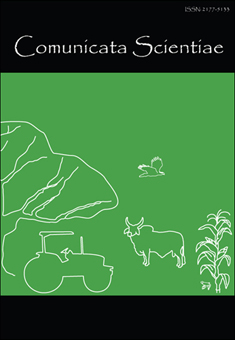Sensibility of weeds to the residual activity of pyrithiobac-sodium
DOI:
https://doi.org/10.14295/cs.v4i3.315Keywords:
inibidor de acetolactato sintetase, Solanaceae, Rubiaceae, Commelinaceae, Convolvulaceae.Abstract
Pyrithiobac-sodium is a selective systemic herbicide for cotton, widely used for weed control in thiscrop. This herbicide has soil activity, but little is known about the effect of the residual in the weedscontrol. This study aimed to evaluate the effect of residual activity of pyrithiobac-sodium in thecontrol of important weeds of cotton crop. Five experiments were conducted (number of weeds) ingreen-house. The experiment was installed in a factorial arrangement (3 x 4) + 1, it was three timesof application of the herbicide before sowing (20, 10 and 0 DBS) and four doses of pyrithiobacsodium(28, 56, 84 and 112 g ha -1), and an additional treatment that served as a control withoutherbicide. Residual activity of pyrithiobac-sodium caused restriction of the vegetative growth of allweeds. The species that demonstrated high sensibility to the residual activity of pyrithiobac-sodiumwere, in descending order: apple of Peru (Nicandra physaloides), american black nightshade(Solanum americanum), buttonweed (Spermacoce latifolia), benghal dayflower (C. benghalensis)and morning glory (I. grandifolia).Downloads
Published
2013-10-01
How to Cite
Pereira Braz, G. B., Oliveira Jr., R. S. de, Constantin, J., Dan, H. A., Gemelli, A., & Rios, F. A. (2013). Sensibility of weeds to the residual activity of pyrithiobac-sodium. Comunicata Scientiae, 4(3), 244–254. https://doi.org/10.14295/cs.v4i3.315
Issue
Section
Original Article
License
All articles published may be reproduced or utilized in any form or by any means whether specified Comunicata Scientiae, author(s), volume, pages and year. The authors are responsible for all the statements and concepts contained in the article.




